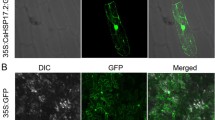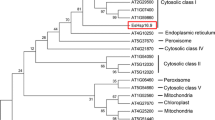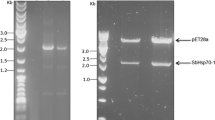Abstract
hspA encodes a small heat shock protein (sHSP) in Xanthomonas campestris pv. campestris, the causative agent of black rot in cruciferous plants. In this study, two-dimensional gel electrophoresis, promoter activity assays, and Northern hybridization results revealed that HspA expression was induced by heat shock but not by other stresses, although low-level expression was detectable by reverse transcription-polymerase chain reaction (RT-PCR) under normal culture conditions. An hspA mutant exhibited reduced tolerance to heat, especially in the presence of MgSO4, but no change in pathogenicity. Results of size-exclusion chromatography indicated that purified HspAhis, containing six C-terminal histidine residues, formed two different size classes of oligomeric complexes—410 and 820 kDa. In contrast, HspAter, the unmodified protein translated from the original hspA gene, formed only the 820-kDa complex. These results suggest that the C-terminus of HspA is important for oligomerization. Both HspA820his and HspA410his were able to partially protect luciferase against heat-induced aggregation. Unlike other reported sHSPs that commonly capture denaturing proteins in refoldable states until refolded by adenosine triphosphate-dependent chaperone systems, HspAhis alone was capable of reactivating heat-inactivated EcoRI. Thus, Xanthomonas campestris pv. campestris HspA has potential application as a protective agent during the storage of proteins.








Similar content being viewed by others
References
Basha E, Lee GJ, Breci LA, Hausrath AC, Buan NR, Giese KC, Vierling E (2004) The identity of proteins associated with a small heat shock protein during heat stress in vivo indicates that these chaperones protect a wide range of cellular functions. J Biol Chem 279:7566–7575
Cashikar AG, Duennwald M, Lindquist SL (2005) A chaperone pathway in protein disaggregation. Hsp26 alters the nature of protein aggregates to facilitate reactivation by Hsp104. J Biol Chem 280:23869–23875
Chang Z, Primm TP, Jakana J, Lee IH, Serysheva I, Chiu W, Gilbert HF, Quiocho FA (1996) Mycobacterium tuberculosis 16-kDa antigen (Hsp16.3) functions as an oligomeric structure in vitro to suppress thermal aggregation. J Biol Chem 271:7218–7223
Chou FL, Chou HC, Lin YS, Yang BY, Lin NT, Weng SF, Tseng YH (1997) The Xanthomonas campestris gumD gene required for synthesis of xanthan gum is involved in normal pigmentation and virulence in causing black rot. Biochem Biophys Res Commun 233:265–269
Dabir DV, Trojanowski JQ, Richter-Landsberg C, Lee VM, Forman MS (2004) Expression of the small heat-shock protein αβ-crystallin in tauopathies with glial pathology. Am J Pathol 164:155–166
Ehrnsperger M, Graber S, Gaestel M, Buchner J (1997) Binding of non-native protein to Hsp25 during heat shock creates a reservoir of folding intermediates for reactivation. EMBO J 16:221–229
Ehrnsperger M, Lilie H, Gaestel M, Buchner J (1999) The dynamics of Hsp25 quaternary structure. J Biol Chem 274:14867–14874
Giese KC, Vierling E (2002) Changes in oligomerization are essential for the chaperone activity of a small heat shock protein in vivo and in vitro. J Biol Chem 277:46310–46318
Gu L, Abulimiti A, Li W, Chang Z (2002) Monodisperse Hsp16.3 nonamer exhibits dynamic dissociation and reassociation, with the nonamer dissociation prerequisite for chaperone-like activity. J Mol Biol 319:517–526
Haley DA, Horwitz J, Stewart PL (1998) The small heat-shock protein, αβ-crystallin, has a variable quaternary structure. J Mol Biol 277:27–35
Haley DA, Bova MP, Huang QL, McHaourab HS, Stewart PL (2000) Small heat-shock protein structures reveal a continuum from symmetric to variable assemblies. J Mol Biol 298:261–272
Han MJ, Yun H, Lee SY (2008) Microbial small heat shock proteins and their use in biotechnology. Biotechnol Adv 26:591–609
Horwitz J (1992) α-Crystallin can function as a molecular chaperone. Proc Natl Acad Sci USA 89:10449–10453
Horwitz J, Bova MP, Ding LL, Haley DA, Stewart PL (1999) Lens α-crystallin: function and structure. Eye (Lond) 13(Pt 3b):403–408
Kappe G, Leunissen JA, de Jong WW (2002) Evolution and diversity of prokaryotic small heat shock proteins. Prog Mol Subcell Biol 28:1–17
Kim KK, Kim R, Kim SH (1998a) Crystal structure of a small heat-shock protein. Nature 394:595–599
Kim R, Kim KK, Yokota H, Kim SH (1998b) Small heat shock protein of Methanococcus jannaschii, a hyperthermophile. Proc Natl Acad Sci USA 95:9129–9133
Kim DR, Lee I, Ha SC, Kim KK (2003) Activation mechanism of HSP16.5 from Methanococcus jannaschii. Biochem Biophys Res Commun 307:991–998
Kirschner M, Winkelhaus S, Thierfelder JM, Nover L (2000) Transient expression and heat-stress-induced co-aggregation of endogenous and heterologous small heat-stress proteins in tobacco protoplasts. Plant J 24:397–411
Lee GJ, Vierling E (2000) A small heat shock protein cooperates with heat shock protein 70 systems to reactivate a heat-denatured protein. Plant Physiol 122:189–198
Lee GJ, Roseman AM, Saibil HR, Vierling E (1997) A small heat shock protein stably binds heat-denatured model substrates and can maintain a substrate in a folding-competent state. EMBO J 16:659–671
Lee TC, Chen ST, Lee MC, Chang CM, Chen CH, Weng SF, Tseng YH (2001) The early stages of filamentous phage phiLf infection require the host transcription factor, Clp. J Mol Microbiol Biotechnol 3:471–481
Lee U, Wie C, Escobar M, Williams B, Hong SW, Vierling E (2005) Genetic analysis reveals domain interactions of Arabidopsis Hsp100/ClpB and cooperation with the small heat shock protein chaperone system. Plant Cell 17:559–571
Leroux MR, Melki R, Gordon B, Batelier G, Candido EP (1997) Structure–function studies on small heat shock protein oligomeric assembly and interaction with unfolded polypeptides. J Biol Chem 272:24646–24656
Lin CH (2004) Functional analysis of small heat shock protein HspA in Xanthomonas campestris pv. campestris and characterization of plasmid pSM76 of Stenotrophomonas maltophilia. Master thesis, National Chung Hsing University
Lin NT, Tseng YH (1997) Sequence and copy number of the Xanthomonas campestris pv. campestris gene encoding 16S rRNA. Biochem Biophys Res Commun 235:276–280
Lini N, Rehna EA, Shiburaj S, Maheshwari JJ, Shankernarayan NP, Dharmalingam K (2008) Functional characterization of a small heat shock protein from Mycobacterium leprae. BMC Microbiol 8:208
MacRae TH (2000) Structure and function of small heat shock α-crystallin proteins: established concepts and emerging ideas. Cell Mol Life Sci 57:899–913
Nakamoto H, Vigh L (2007) The small heat shock proteins and their clients. Cell Mol Life Sci 64:294–306
Narberhaus F (2002) α-Crystallin-type heat shock proteins: socializing minichaperones in the context of a multichaperone network. Microbiol Mol Biol Rev 66:64–93
Plesofsky-Vig N, Brambl R (1995) Disruption of the gene for hsp30, an α-crystallin-related heat shock protein of Neurospora crassa, causes defects in thermotolerance. Proc Natl Acad Sci USA 92:5032–5036
Ratajczak E, Zietkiewicz S, Liberek K (2009) Distinct activities of Escherichia coli small heat shock proteins IbpA and IbpB promote efficient protein disaggregation. J Mol Biol 386:178–189
Sambrook J, Russell DW (2001) Molecular cloning: a laboratory manual, 3rd edn. Cold Spring Harbor Laboratory, Cold Spring Harbor
Schweizer HD (1993) Small broad-host-range gentamycin resistance gene cassettes for site-specific insertion and deletion mutagenesis. Biotechniques 15:831–834
Sun Y, MacRae TH (2005) The small heat shock proteins and their role in human disease. FEBS J 272:2613–2627
van Montfort RL, Basha E, Friedrich KL, Slingsby C, Vierling E (2001) Crystal structure and assembly of a eukaryotic small heat shock protein. Nat Struct Biol 8:1025–1030
Vieira J, Messing J (1991) New pUC-derived cloning vectors with different selectable markers and DNA replication origins. Gene 100:189–194
Wang SW (2000) Construction and characterization of Xanthomonas campestris pv. campestris 17 hrcA mutant. Master thesis, National Chung Hsing University
Wang TW, Tseng YH (1992) Electrotransformation of Xanthomonas campestris by RF DNA of filamentous phage phiLf. Lett Appl Microbiol 14:65–68
Weng SF, Tai PM, Yang CH, Wu CD, Tsai WJ, Lin JW, Tseng YH (2001) Characterization of stress-responsive genes, hrcA–grpE–dnaK–dnaJ, from phytopathogenic Xanthomonas campestris. Arch Microbiol 176:121–128
Williams PH (1980) Black rot: a continuing threat to world crucifers. Plant Dis 64:736–742
Yang BY, Tsai HF, Tseng YH (1988) Broad host range cosmid pLAFR1 and non-mucoid mutant XCP20 provide a suitable vector–host system for cloning genes in Xanthomonas campestris pv. campestris. Zhonghua Min Guo Wei Sheng Wu Ji Mian Yi Xue Za Zhi 21:40–49
Acknowledgments
We gratefully acknowledge Dr. M.-T. Yang for providing the AKTA protein purification machine and other materials. This study was supported by grant NSC-94-2313-B-005-029 from the National Science Council, Republic of China.
Author information
Authors and Affiliations
Corresponding authors
Rights and permissions
About this article
Cite this article
Lin, CH., Lee, CN., Lin, JW. et al. Characterization of Xanthomonas campestris pv. campestris heat shock protein A (HspA), which possesses an intrinsic ability to reactivate inactivated proteins. Appl Microbiol Biotechnol 88, 699–709 (2010). https://doi.org/10.1007/s00253-010-2776-z
Received:
Revised:
Accepted:
Published:
Issue Date:
DOI: https://doi.org/10.1007/s00253-010-2776-z




